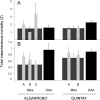Exploitation rates of two benthic resources across management regimes in central Chile: Evidence of illegal fishing in artisanal fisheries operating in open access areas
- PMID: 28666013
- PMCID: PMC5493345
- DOI: 10.1371/journal.pone.0180012
Exploitation rates of two benthic resources across management regimes in central Chile: Evidence of illegal fishing in artisanal fisheries operating in open access areas
Erratum in
-
Correction: Exploitation rates of two benthic resources across management regimes in central Chile: Evidence of illegal fishing in artisanal fisheries operating in open access areas.PLoS One. 2018 Jan 9;13(1):e0191166. doi: 10.1371/journal.pone.0191166. eCollection 2018. PLoS One. 2018. PMID: 29315337 Free PMC article.
Abstract
There is an urgent need to quantify the impacts of artisanal fisheries and define management practices that allow for the recovery and conservation of exploited stocks. The extent of illegal catch is particularly critical as a driver of overexploitation in artisanal fisheries. However, the lack of data at proper spatial scales limits the evaluation of illegal fishing and effectiveness of management practices. We used a catch curve analysis to estimate total instantaneous mortality as a proxy of fishing pressure in the artisanal benthic fishery in central Chile. We compared the patterns of total mortality in fishing grounds under the well-studied territorial use rights for fisheries system (TURF) immersed in a landscape of open access areas (OAA; no access restriction), and from these patterns determined the extent of illegal fishing in open access areas focusing on the two most frequently extracted resources: locos (Concholepas concholepas) and keyhole limpets (Fissurella spp.). The beauty of this seascape is the presence of the no-take (NT) area of Las Cruces as control (no fishing), allowing us to estimate natural mortality. Loco exploitation is banned in OAAs. However, loco mortality in OAAs was 92% higher than in the NT, and 42% higher than in TURFs. Keyhole limpet mortality was similar between TURFs and the NT, but doubled in OAAs. We also found strong differences in mortality among fishing grounds with the same level of protection (i.e. TURFs), and over time. Our results highlight (a) the high level of illegal fishing that may occur in artisanal fisheries under traditional management regimes, and (b) that TURFs can be effective to reduce fishing mortality. However, large variability among TURFs suggests the need for a deeper understanding of the drivers of success of TURFs.
Conflict of interest statement
Figures




Similar articles
-
Illegal fishing and territorial user rights in Chile.Conserv Biol. 2018 Jun;32(3):619-627. doi: 10.1111/cobi.13048. Epub 2018 Mar 6. Conserv Biol. 2018. PMID: 29114934
-
Add-on conservation benefits of marine territorial user rights fishery policies in central Chile.Ecol Appl. 2008 Jan;18(1):273-81. doi: 10.1890/06-1896.1. Ecol Appl. 2008. PMID: 18372572
-
Egg production patterns of two invertebrate species in rocky subtidal areas under different fishing regimes along the coast of central Chile.PLoS One. 2017 May 8;12(5):e0176758. doi: 10.1371/journal.pone.0176758. eCollection 2017. PLoS One. 2017. PMID: 28481886 Free PMC article.
-
The northern shrimp (Pandalus borealis) offshore fishery in the Northeast Atlantic.Adv Mar Biol. 2007;52:147-266. doi: 10.1016/S0065-2881(06)52002-4. Adv Mar Biol. 2007. PMID: 17298891 Review.
-
Overview of Patagonian Red Octopus (Enteroctopus megalocyathus) Fisheries in Chilean Regions and Their Food Safety Aspects.Animals (Basel). 2025 May 19;15(10):1464. doi: 10.3390/ani15101464. Animals (Basel). 2025. PMID: 40427341 Free PMC article. Review.
Cited by
-
Estimating illegal fishing from enforcement officers.Sci Rep. 2020 Jul 27;10(1):12478. doi: 10.1038/s41598-020-69311-5. Sci Rep. 2020. PMID: 32719385 Free PMC article.
-
Correction: Exploitation rates of two benthic resources across management regimes in central Chile: Evidence of illegal fishing in artisanal fisheries operating in open access areas.PLoS One. 2018 Jan 9;13(1):e0191166. doi: 10.1371/journal.pone.0191166. eCollection 2018. PLoS One. 2018. PMID: 29315337 Free PMC article.
-
Monitoring the fabric of nature: using allometric trophic network models and observations to assess policy effects on biodiversity.Philos Trans R Soc Lond B Biol Sci. 2023 Jul 17;378(1881):20220189. doi: 10.1098/rstb.2022.0189. Epub 2023 May 29. Philos Trans R Soc Lond B Biol Sci. 2023. PMID: 37246381 Free PMC article.
-
Integrating human and ecological dimensions: The importance of stakeholders' perceptions and participation on the performance of fisheries co-management in Chile.PLoS One. 2021 Aug 11;16(8):e0254727. doi: 10.1371/journal.pone.0254727. eCollection 2021. PLoS One. 2021. PMID: 34379635 Free PMC article.
-
Alteration of coastal productivity and artisanal fisheries interact to affect a marine food web.Sci Rep. 2021 Jan 19;11(1):1765. doi: 10.1038/s41598-021-81392-4. Sci Rep. 2021. PMID: 33469119 Free PMC article.
References
-
- Worm B, Hilborn R, Baum JK, Branch TA, Collie JS, Costello C, Fogarty MJ, Fulton EA, Hutchings JA, Jennings S, Jensen OP, Lotze HK, Mace PM, McClanahan TR, Minto C, Palumbi SR, Parma AM, Ricard D, Rosenberg AA, Watson R, Zeller D. Rebuilding Global Fisheries. Science. 2009; 325: 578–585. doi: 10.1126/science.1173146 - DOI - PubMed
-
- Ricard D, Minto C, Jensen OP, Baum JK. Examining the knowledge base and status of commercially exploited marine species with the RAM Legacy Stock Assessment Database. Fish Fish. 2012; 13: 380–398.
-
- Costello C, Ovando D, Hilborn R, Gaines SD, Deschenes O, Lester SE. Status and solutions for the world’s unassessed fisheries. Science. 2012; 338: 517–520. doi: 10.1126/science.1223389 - DOI - PubMed
-
- Berkes F, Mahon R, McConney P, Pollnac R, Pomeroy R. Managing small-scale fisheries: alternative directions and methods. 1st ed Ottawa: International Development Research Centre; 2001.
-
- Berkes F. Alternatives to conventional management: lessons from small-scale fisheries. Environments. 2003; 31: 5–19.
MeSH terms
LinkOut - more resources
Full Text Sources
Other Literature Sources
Research Materials
Miscellaneous

